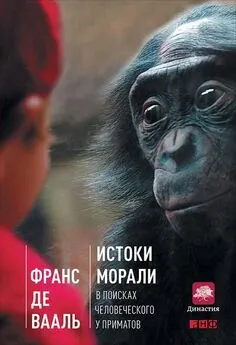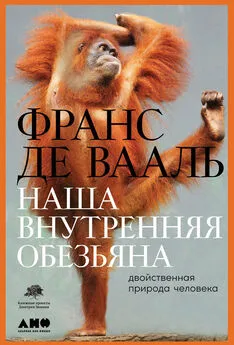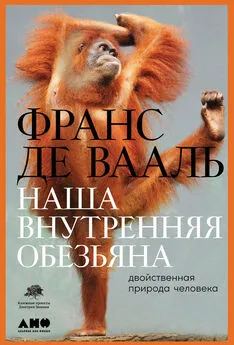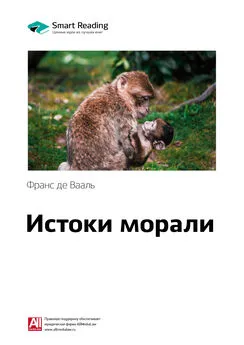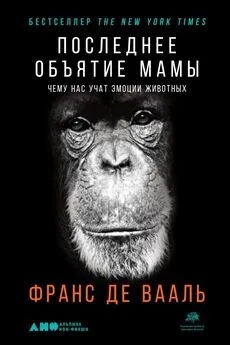Франс Вааль - Последнее объятие Мамы [litres]
- Название:Последнее объятие Мамы [litres]
- Автор:
- Жанр:
- Издательство:Литагент Альпина
- Год:2020
- Город:Москва
- ISBN:978-5-0013-9214-9
- Рейтинг:
- Избранное:Добавить в избранное
-
Отзывы:
-
Ваша оценка:
Франс Вааль - Последнее объятие Мамы [litres] краткое содержание
В этой доброй и умной книге, помимо трогательной истории шимпанзе по имени Мама, известный приматолог Франс де Вааль рассказывает о своих многочисленных наблюдениях и экспериментах, посвященных изучению эмоций самых разных животных. Наряду с гневом и ненавистью, приводящими даже к преднамеренному убийству себе подобных, животные обнаруживают удивительную способность к состраданию, примирению и прощению. Они, как и мы, способны к эмпатии, взаимопомощи и тесному социальному взаимодействию.
Автор рассматривает чувства человека в эволюционном контексте как прямое продолжение эмоций животных и призывает осознать нашу неразрывную связь со всеми существами на планете и в конечном счете лучше понять самих себя.
Последнее объятие Мамы [litres] - читать онлайн бесплатно ознакомительный отрывок
Интервал:
Закладка:
Gazzaniga, M. S. 2008. Human: The Science Behind What Makes Your Brain Unique . New York: Ecco.
Gesquiere, L. R., et al. 2011. Life at the top: Rank and stress in wild male baboons. Science 333:357–60.
Ghiselin, M. 1974. The Economy of Nature and the Evolution of Sex . Berkeley: University of California Press.
Godfrey-Smith, P. 2016. Other Minds: The Octopus, the Sea, and the Deep Origins of Consciousness . New York: Farrar, Strauss and Giroux.
Goldstein, P., I. Weissman-Fogel, G. Dumas, and S. G. Shamay-Tsoory. 2018. Brain-to-brain coupling during handholding is associated with pain reduction. Proceedings of the National Academy of Sciences USA 115:201703643.
Goleman, D. 1995. Emotional Intelligence . New York: Bantam.
Goodall, J. 1986a. The Chimpanzees of Gombe: Patterns of Behavior . Cambridge, MA: Belknap.
–. 1986b. Social rejection, exclusion, and shunning among the Gombe chimpanzees. Ethology and Sociobiology 7:227–36.
–. 1990. Through a Window: My Thirty Years with the Chimpanzees of Gombe . Boston: Houghton Mifflin.
Grandin, T., and C. Johnson. 2009. Animals Make Us Human: Creating the Best Life for Animals . Boston: Houghton Mifflin.
Greenfeld, L. 2013. Are human emotions universal? Psychology Today.
Haeckel, E. 2012 [orig. 1884]. The History of Creation, Or the Development of the Earth and its Inhabitants by the Action of Natural Causes , vol. 1. Project Gutenberg.
Hampton, R. R. 2001. Rhesus monkeys know when they remember. Proceedings of the National Academy of Sciences USA 98:5359–62.
Hare, B., and S. Kwetuenda. 2010. Bonobos voluntarily share their own food with others. Current Biology 20: R230 – R231.
Hebb, D. O. 1946. Emotion in man and animal: An analysis of the intuitive processes of recognition. Psychological Review 53:88–106.
Herculano-Houzel, S. 2009. The human brain in numbers: A linearly scaledup primate brain. Frontiers in Human Neuroscience 3:1–11.
–. 2016. The Human Advantage: A New Understanding of How Our Brain Became Remarkable . Cambridge, MA: MIT Press.
Herculano-Houzel, S., et al. 2014. The elephant brain in numbers. Frontiers in Neuroanatomy 8:46.
Hillman, K. L., and D. K. Bilkey. 2010. Neurons in the rat Anterior Cingulate Cortex dynamically encode cost-benefit in a spatial decision-making task. Journal of Neuroscience 30:7705–13.
Hills, T. T., and S. Butterfill. 2015. From foraging to autonoetic consciousness: The primal self as a consequence of embodied prospective foraging. Current Zoology 61:368–81.
Hobaiter, C., and R. W. Byrne. 2010. Able-bodied wild chimpanzees imitate a motor procedure used by a disabled individual to overcome handicap. PLoS ONE 5: e11959.
Hockings, K. J., et al. 2007. Chimpanzees share forbidden fruit. PLoS ONE 2: e886.
Hofer, M. K., H. K. Collins, A. V. Whillans, and F. S. Chen. 2018. Olfactory cues from romantic partners and strangers influence women’s responses to stress. Journal of Personality and Social Psychology 114:1–9.
Hoffman, M. L. 1981. Is altruism part of human nature? Journal of Personality and Social Psychology 40:121–37.
Horgan, J. 2014. Thanksgiving and the slanderous myth of the savage savage. Scientific American Cross-Check Blog .
Horner, V., and F. B. M. de Waal. 2009. Controlled studies of chimpanzee cultural transmission. Progress in Brain Research 178:3–15.
Horner, V., D. J. Carter, M. Suchak, and F. B. M. de Waal, 2011. Spontaneous prosocial choice by chimpanzees. Proceedings of the Academy of Sciences USA 108:13847–51.
Horowitz, A. 2009. Inside of a Dog: What Dogs See, Smell, and Know . New York: Scribner.
Hrdy, S. B. 2009. Mothers and Others: The Evolutionary Origins of Mutual Understanding . Cambridge, MA: Belknap.
James, W. 1950 [orig. 1890]. The Principles of Psychology . New York: Dover.
Janmaat, K. R. L., L. Polansky, S. D. Ban, and C. Boesch. 2014. Wild chimpanzees plan their breakfast time, type, and location. Proceedings of the National Academy of Sciences USA 111:16343–48.
Jasanoff, A. 2018. The Biological Mind: How Brain, Body, and Environment Collaborate to Make Us Who We Are . New York: Basic Books.
Kaburu, S. S. K., S. Inoue, and N. E. Newton-Fisher. 2013. Death of the alpha: Within-сommunity lethal violence among chimpanzees of the Mahale Mountains National Park. American Journal of Primatology 75:789–97.
Kaminski, J., et al. 2017. Human attention affects facial expressions in domestic dogs. Scientific Reports 7:12914.
Kano, T. 1992. The Last Ape: Pygmy Chimpanzee Behavior and Ecology . Stanford, CA: Stanford University Press.
Kellogg, W. N., and L. A. Kellogg. 1967 [orig. 1933]. The Ape and the Child: A Study of Environmental Influence upon Early Behavior . New York: Hafner.
King, B. J. 2013. How Animals Grieve . Chicago: University of Chicago Press.
Koepke, A. E., S. L. Gray, and I. M. Pepperberg. 2015. Delayed gratification: A grey parrot ( Psittacus erithacus ) will wait for a better reward. Journal of Comparative Psychology 129:339–46.
Kraus, M. W., and T. W. Chen. 2013. A winning smile? Smile intensity, physical dominance, and fighter performance. Emotion 13:270–79.
Kropotkin, P. 2009 [orig. 1902]. Mutual Aid: A Factor of Evolution . New York: Cosimo.
Ladygina-Kohts, N. N. 2002 [orig. 1935]. Infant Chimpanzee and Human Child: A Classic 1935 Comparative Study of Ape Emotions and Intelligence . Ed. F. B. M. de Waal. Oxford: Oxford University Press.
Lahr, J. 2000. Dame Edna Everage and the Rise of Western Civilisation: Backstage with Barry Humphries , 2nd ed. Berkeley: University of California Press.
Langford, D. J., et al. 2010. Coding of facial expressions of pain in the laboratory mouse. Nature Methods 7:447–49.
Lazarus, R., and B. Lazarus. 1994. Passion and Reason . New York: Oxford University Press.
LeDoux, J. E. 2014. Coming to terms with fear. Proceedings of the National Academy of Sciences USA 111:2871–78.
Leuba, J. H. 1928. Morality among the animals. Harper’s Monthly 937:97–103.
Limbrecht-Ecklundt, K., et al. 2013. The effect of forced choice on facial emotion recognition: A comparison to open verbal classification of emotion labels. GMS Psychosocial Medicine 10.
Lindegaard, M. R., et al. 2017. Consolation in the aftermath of robberies resembles post-aggression consolation in chimpanzees. PLoS ONE 12: e0177725.
Lipps, T. 1903. Einfühlung, innere Nachahmung und Organenempfindungen. Archiv für die gesamte Psychologie 1:465–519.
Lorenz, K. 1960. So kam der Mensch auf den Hund . Vienna: Borotha-Schoeler.
–. 1966. On Aggression . New York: Harcourt.
–. 1980. Tiere sind Gefühlsmenschen. Der Spiegel 47:251–64.
Magee, B., and R. E. Elwood. 2013. Shock avoidance by discrimination learning in the shore crab ( Carcinus maenas ) is consistent with a key criterion for pain. Journal of Experimental Biology 216:353–58.
Maslow, A. H. 1936. The role of dominance in the social and sexual behavior of infra-human primates: I. Observations at Vilas Park Zoo. Journal of Genetic Psychology 48:261–77.
Masson, J. M., and S. McCarthy. 1995. When Elephants Weep: The Emotional Lives of Animals . New York: Delacorte.
Mathuru, A. S., et al. 2012. Chondroitin fragments are odorants that trigger fear behavior in fish. Current Biology 22:538–44.
Matsuzawa, T. 2011. What is uniquely human? A view from comparative cognitive development in humans and chimpanzees. In The Primate Mind , ed. F. B. M. de Waal and P. F. Ferrari, 288–305. Cambridge, MA: Harvard University Press.
McConnell, P. 2005. For the Love of a Dog . New York: Ballantine Books.
McFarland, D. 1987. The Oxford Companion to Animal Behaviour . Oxford: Oxford University Press.
Mendl, M., O. H. P. Burman, and E. S. Paul. 2010. An integrative and functional framework for the study of animal emotion and mood. Proceeding of the Royal Society B 277:2895–904.
Michl, P., et al. 2014. Neurobiological underpinnings of shame and guilt: A pilot fMRI study. Social Cognitive and Affective Neuroscience 9:150–57.
Miller, K. R. 2018. The Human Instinct: How We Evolved to Have Reason, Consciousness, and Free Will . New York: Simon and Schuster.
Mogil, J. S. 2015. Social modulation of and by pain in humans and rodents. PAIN 156: S35 – S41.
Mulder, M. 1977. The Daily Power Game . Amsterdam: Nijhoff.
Nagasaka, Y. et al. 2013. Spontaneous synchronization of arm motion between Japanese macaques. Scientific Reports 3:1151.
Neal, D. T., and T. L. Chartrand. 2011. Amplifying and dampening facial feedback modulates emotion perception accuracy. Social Psychological and Personality Science 2:673–78.
Nishida, T. 1996. The death of Ntologi: The unparalleled leader of M Group. Pan Africa News 3:4.
Norscia, I., and E. Palagi. 2011. Yawn contagion and empathy in Homo sapiens. PloS ONE 6: e28472.
Nowak, M., and R. Highfield. 2011. SuperCooperators: Altruism, Evolution, and Why We Need Each Other to Succeed . New York: Free Press.
Nummenmaa, L., E. Glerean, R. Hari, and J. K. Hietanen. 2014. Bodily maps of emotions. Proceedings of the National Academy of Sciences USA 111:646–51.
Nussbaum, M. 2001. Upheavals of Thought: The Intelligence of Emotions . Cambridge: Cambridge University Press.
O’Brien, E., S. H. Konrath, D. Grühn, and A. L. Hagen. 2013. Empathic concern and perspective taking: Linear and quadratic effects of age across the adult life span. Journals of Gerontology, Series B: Psychological Sciences and Social Sciences 68:168–75.
O’Connell, C. 2015. Elephant Don: The Politics of a Pachyderm Posse . Chicago: University of Chicago Press.
O’Connell, M. 2017. To Be a Machine . London: Granta.
Ortony, A., and T. J. Turner. 1990. What’s basic about basic emotions? Psychological Review 97:315–31.
Osvath, M., and H. Osvath. 2008. Chimpanzee ( Pan troglodytes ) and orangutan ( Pongo abelii ) forethought: Self-control and pre-experience in the face of future tool use. Animal Cognition 11:661–74.
Panksepp, J. 1998. Affective Neuroscience: The Foundations of Human and Animal Emotions . New York: Oxford University Press.
–. 2005. Affective consciousness: Core emotional feelings in animals and humans. Consciousness and Cognition 14:30–80.
Panksepp, J., and Burgdorf, J. 2003. “Laughing” rats and the evolutionary antecedents of human joy? Physiology and Behavior 79:533–47.
Panoz-Brown, D., et al. 2018. Replay of episodic memories in the rat. Current Biology 28:1–7.
Parr, L. A. 2001. Cognitive and physiological markers of emotional awareness in chimpanzees ( Pan troglodytes ). Animal Cognition 4:223–29.
Parr, L. A., M. Cohen, and F. B. M. de Waal. 2005. Influence of social context on the use of blended and graded facial displays in chimpanzees. International Journal of Primatology 26:73–103.
Paukner, A., S. J. Suomi, E. Visalberghi, and P. F. Ferrari. 2009. Capuchin monkeys display affiliation toward humans who imitate them. Science 325:880–83.
Читать дальшеИнтервал:
Закладка:
![Обложка книги Франс Вааль - Последнее объятие Мамы [litres]](/books/1075030/frans-vaal-poslednee-obyatie-mamy-litres.webp)

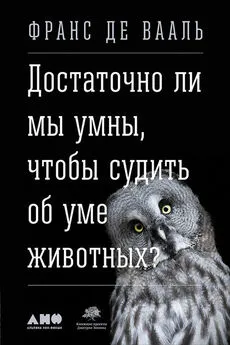
![Дебра Мерк - Девочка в гараже [Реальная история приемной мамы] [litres]](/books/1060538/debra-merk-devochka-v-garazhe-realnaya-istoriya-prie.webp)
